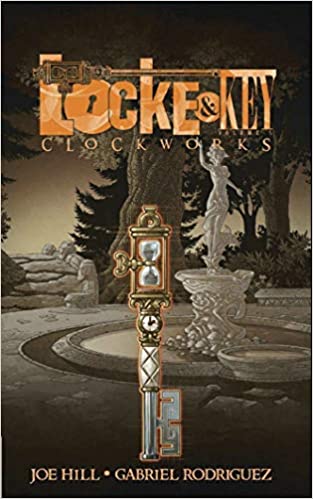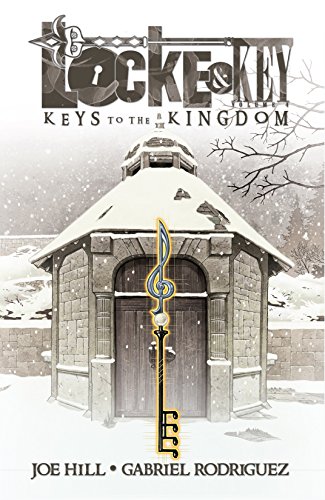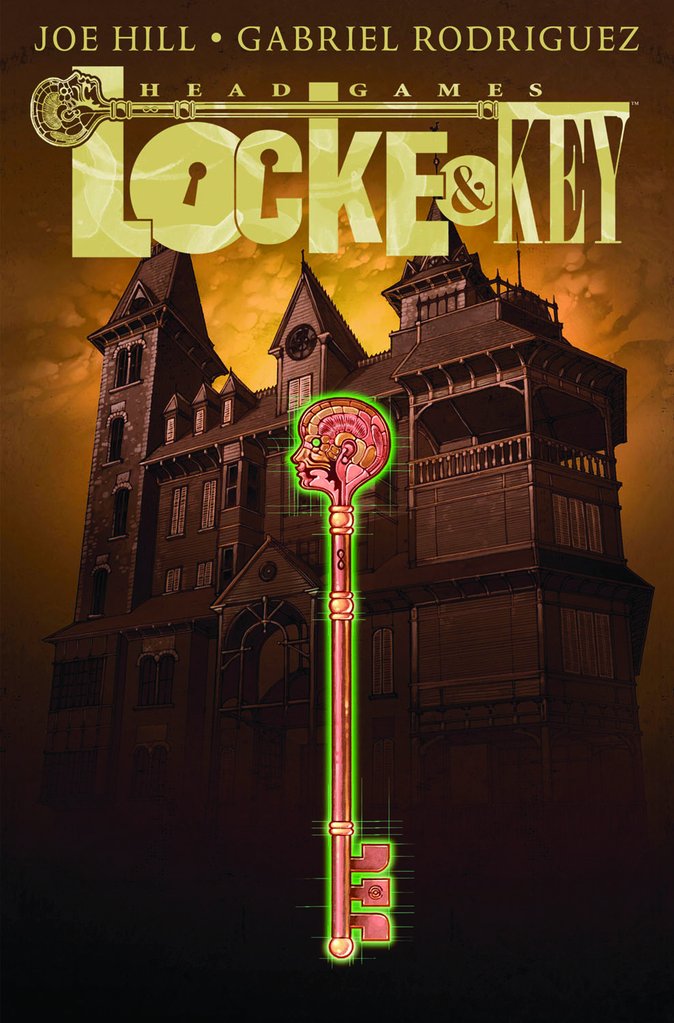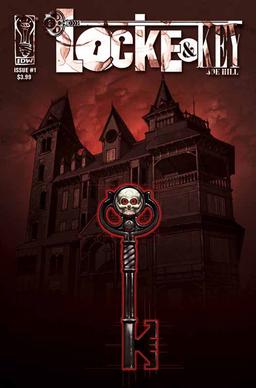written by David Steffen
Since the vast majority of my fiction intake is through audio, while I’m driving or doing dishes or picking up sticks or what-have-you, I have made little effort to keep up with graphic stories, even though I am a fan of the medium . Other than some classic X-Men and Spider-Man comics anyway.
So, here’s my chance to read some of the most popular of the year. Some of these are part of series, in which case I can only judge them based on themselves, not on any knowledge of the rest of the series, so keep that in mind.
Hugo Award for Best Graphic Story
1. Locke & Key, Vol. 5: Clockworks, Joe Hill, art by Gabriel Rodriguez (IDW)
The main characters of this story live in the present, the children of the Locke family who live in a very strange home in Lovecraft, Massachusetts. They have a strange family history dating back to 1775 (portrayed in the opening chapter of this issue) in which rebels hiding from British soldiers in the Revolutionary War come across a transdimensional door that opens into a world of demons. One look through the doorway, and they snare your mind and twist your intentions. When demons try to cross through they are reduced to hunks of “whispering iron”, a metal which is not obtained through any other way. To save the rebels, the young locksmith and heir of the Locke family forges some of the whispering iron into a lock to hold the transdimensional door shut. Over the years he forges other keys with the whispering iron, each with its own specific magical purpose, and these keys are passed down from generation to generation.
As you might expect, it’s a bit of a learning curve to pick up book 5 in a series of 6. The initial scenes of this one take place in 1775 before anything supernatural is known, but then suddenly in Chapter Two you’re thrown back into the present where there are a bunch of keys which are already taken for granted and used nonchalantly while I tried to figure out what the heck was happening. A couple of strange little nonhuman characters were especially confusing until the main characters see them and explain them in some brief dialog. Obviously this is no fault of the book itself, but at my own reading them out of order. I did eventually figure out everything I needed to understand, and by the climax of the story I understood the rules of the world well enough that I could understand the stakes.
This story was awesome. Very well inked, colored, very well written, scary as hell in parts, and funny in others. This story does a good job explaining who appears to be the main villain, a plotline which will presumably be solved in the next book. I now want to go find the previous four stories in the series, and then read the conclusion in book six.
2. Schlock Mercenary: Random Access Memorabilia Howard Tayler, colors by Travis Walton (Hypernode Media)
The titular character Schlock is an amorphous alien blob who is a member of Tagon’s Toughs interstellar mercenary troop. They have hired on to run security for a colony of Gavs, a race of people who are all copies of the same person (presumably the reason for this was covered in a previous issue, I don’t really know). Things are quiet. Too quiet. Something is bound to go horribly wrong.
I found the main plot of this pretty entertaining, action packed and fun.
Unfortunately, as far as I’m concerned, that main plot didn’t actually get going in any interesting fashion until page 140 of 294 when things start really going wrong. From then on it was well-paced and interesting. The first 50 pages or so appeared to be slow-paced mop-up of the previous issue, which was hard to follow, all the more so because apparently the previous issue involved many of the main characters’ memories being wiped and rewritten, and now memory restoration is happening. A large portion of the story space was taken up with character development of characters I don’t know or care anything about.
This perceived pacing problem is no big surprise for a series that I started on issue # 13, and really it’s probably no flaw in the comic itself for someone who has followed the series. But since I am judging it by this issue alone, the pacing issues are a major flaw.
3. Saga, Volume One, Brian K. Vaughn, art by Fiona Staples (Image)
Baby Hazel is born into a war-torn region of space where fights constantly rage between the planet Landfall and its moon Wreath. She is the child of a man and a woman who are fugitives from opposite sides of the conflict. Meanwhile, bounty hunters hired close in on them.
This story was okay. It seemed to depend primarily on empathizing with Marko and Alana, the fugitive parents, but they never felt like real people to me. Something about their dialogue just made them seem too artificial to care about. Hazel might be a person to empathize with, but in the story she’s only hours and days old, and so is largely unaware of her surroundings. And the story is narrated by her as a retrospective, so obviously she’s survived and done okay for herself. I didn’t really feel connected to other characters in the story either.
It didn’t help that there were some elements of the story that made if very hard to take seriously, such as the character named Prince Robot IV, who is a part of subset of the population that has CRT monitors for heads for no reason that I was able to discern.
The one thing that had me perked up and paying attention was the character The Stalk. She is badass and it would be fun to see a CG version of her.
That said, the drawings were of good quality, the plot was coherent, and I was interested in The Stalk character. But that’s not nearly enough to carry this story.
4. Grandville BĂƒÆ’ ªte Noire, Bryan Talbot (Dark Horse Comics; Jonathan Cape)
“Two hundred years ago Britain lost the Napoleonic War. As with the rest of Europe, it was invaded by France and the members of its royal family were guillotined. It had been part of the French Empire until 23 years ago, when it was begrudgingly given independence after a prolonged campaign of civil disobedience and anarchist bombings. Ten weeks ago, France experienced a revolution following the death of Emperor Napoleon XII and is now ruled by the Revolutionary Council.” This is the introduction to the story, giving you a good taste of its alt-history origins. So far so good, we know the branching point of history, and we have an idea where that’s taken us. The story follows Detective-inspective LeBrock of Scotland Yard and his Watson-esque sidekick Roderick as they investigate the murder of a prominent artist. And he’s just the badger for the job–oh, right, instead of people this world is populated by anthropomorphic animals.
LeBrock seems to be kind of a mix of a Sherlock Holmes kind of detective (complete with his Watson-esque Roderick, a mouse with an over-the-top dialect) and a James Bond kind of government agent. The alt-hist aspect of it is interesting, to see what kind of world the creator imagined from that branching point. Personally, though, I found the choice to mix anthroporphic animals with alt-hist to be distracting and detrimental to my immersion in the story. The two genres just clash with each other, and badly. Alt-hist is generally grounded in plausibility, finding a reasonable branching point and showing us how different things could be. But at no point is there any reason why the animals are there instead of humans. If we were literally replaced by a variety of animals, I can’t believe that human history wouldn’t be MUCH MORE different, certainly not with the same occupations, same cities, etc, that we have today. With the combination of the two I just found it hard to consider the story anything but a big absurd joke. It’s not that humans have just been swapped out for the sake of drawing differently shaped faces either–humans are present in this world as an oppressed minority that the other species call “doughfaces”, who are picketing for rights–this half-inclusion of them just makes things all the more confusing and annoying to me.
Also, I’ve never been a huge fan of mystery stories anyway, I just don’t get that wrapped up in trying to figure it out, and so with the combination of that and the constant distraction of the weird population, I just really didn’t get into this.
The art of this graphic story was well drawn, though I found some of the anthropomorphic animals to be pretty creepy, especially when they’re naked.
5. Saucer Country, Volume 1: Run, Paul Cornell, art by Ryan Kelly, Jimmy Broxton & Goran SudĂƒ… ¾uka (Vertigo)
Presidential candidate Governor Arcadia Alvarado wakes up in her car with her ex-husband, having lost some time. Her recent memories are consistent with alien abduction cases. She must decide what to do in response to this, and how it affects her Presidential campaigning.
I don’t get what this story is supposed to be about. I mean, obviously, about alien abductions on the surface. Alvarado and her staff work toward finding the truth of her experience and the experiences of others, but by the end of the story you just end up with some random images for clues, a handful of competing and conflicting interpretations of what “alien abduction” actually means, and the last chapter is just a rambling treatise detailing one person’s opinion about alien abductions.
To me this reads like an essay written by a UFO enthusiast, shoehorned awkwardly into a story structure with illustrations. It’s not really a story. I guess if you want to hear a person’s opinions on UFO abductions you might enjoy it. But if you’re looking for a story, it’s a disappointment.
This is just volume 1 of the story, but I’d say that any volume of any story needs to have some story arc of its own that is satisfying in its own, just as any book in a series of books. This volume fails at that and I wouldn’t buy a second volume based on this.




